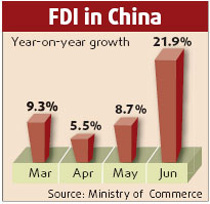The sixth hike of banks' reserve rate this year should not come as a surprise for robust growth figures for the first half year have been calling for more tightening efforts.
However, the pace at which the monetary authorities have acted to mop up excess liquidity is noteworthy. It shows that policymakers are keen to curb lending growth that can stoke an unwelcome investment rebound.
The People's Bank of China raised the reserve requirement ratio by 0.5 percentage points to 12 percent for the country's big lenders on Monday.
The move, like previous ones, is expected to help the central bank to absorb liquidity in the market by about 150 billion yuan ($20 billion). This amount of reduction in liquidity is not very huge in comparison with the country's lending growth. China's commercial banks lent up to 2.5 trillion yuan ($329 billion) in the first half of the year, approaching 80 percent of last year's total.
But the accumulative effect of six such hikes in banks' reserve requirement ratio is fairly considerable now. More importantly, the latest step comes just 10 days after the central bank raised benchmark interest rates by 0.27 percentage points and the State Council cut the tax on interest income from 20 percent to 5 percent.
Such intensified efforts are all aimed at reducing liquidity and stabilizing the blistering economy. The Chinese economy is expanding at the fastest rate in more than a decade. It has grown by 11.5 percent in the first half of the year.
To prevent the economy from overheating, policymakers must take measures to make sure that liquidity and bank lending do not get out of control in the short term.
A key source of excess liquidity is the country's soaring trade surplus. Though the government has adopted a slew of tax and environmental policies to rein in export growth and reduce external imbalance, China will likely continue to reap more trade surplus as a low-cost global manufacturing base.
By ordering lenders to set aside more money as reserves, the central bank has struck at the root of the ongoing rebound of investment. For the sake of profitability, commercial banks are eager to grant more loans when liquidity remains abundant.
(China Daily August 1, 2007)


